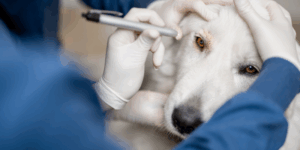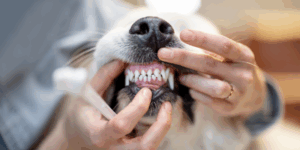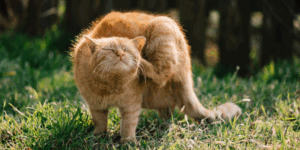Morris’ graze with danger
June 8, 2023

Morris’ graze with danger
How many amazing medical skills and services do our veterinary hospitals have to offer? To show you, we’d like to tell the story of little Morris, who had an unfortunate run-in with a car.
One day, Morris the six-month-old Schnauzer pup was full of beans and feeling adventurous. When his owner Sarah opened the front door to receive a delivery, Morris took his chance and gleefully dashed outside. He ran onto the street, with Sarah running along behind, trying to call him back. Before she could catch him, Morris darted through a gap between two parked cars and into the path of an oncoming vehicle.
Sarah heard the skid of tires, a bump, and Morris’s pained yelp. She ran onto the street to find Morris sitting by the gutter, trembling, and bleeding from a wound on his forelimb.
After a brief exchange with the devastated car driver to assure them it wasn’t their fault, Sarah scooped up Morris (who yelped again) and rushed him to the local veterinary hospital.
Sarah arrived at the clinic in tears. The veterinary nursing team quickly jumped into action, and while one nurse took Morris through for immediate triage (a brief assessment of his vital functions and injuries), another nurse fetched a vet to quickly assess him, and a third stayed with Sarah to calm and comfort her and discuss the immediate healthcare options for Morris.
Sarah gave permission for the vet, Dr Moss, to administer some pain relief to Morris, and perform any treatments or diagnostics required to stabilise and assess him.
After the pain relief injection, Morris relaxed considerably. Overall, he seemed to be stable but was limping on his right front leg (which had some deep wounds contaminated with road debris) and he seemed sore around his chest.
The vet started Morris on intravenous fluids to support his blood pressure and quickly flushed his wounds with saline before applying temporary bandages. Dr Moss performed chest and forelimb x-rays (which showed only mild lung bruising), and a brief ultrasound scan of Morris’s belly to ensure there were no signs of internal bleeding or bladder damage. Luckily, it appeared as though the car had only contacted Morris’s leg and chest at a relatively low speed, causing tissue damage but no bone breakages.
With Morris in a stable condition, the veterinary team treated his deep skin wounds under anaesthetic. Whilst a nurse monitored Morris, Dr Moss cleaned the wounds of debris and applied medical-grade honey (to help prevent microbial infection and promote wound healing) and protective dressings.
Morris stayed in the hospital for two days before he was deemed healthy enough to go home, requiring another three weeks of regular bandage changes for his forelimb wounds to heal. Once he had fully recovered, Morris and Sarah attended an advanced training course to work on Morris’s general obedience!
Sarah was extremely grateful to the veterinary team for their rapid, thorough and compassionate assistance. On behalf of Morris, Sarah and other pet families, we’d like to give an appreciative shout-out to all the veterinary teams out there who provide such wonderful professional care.





